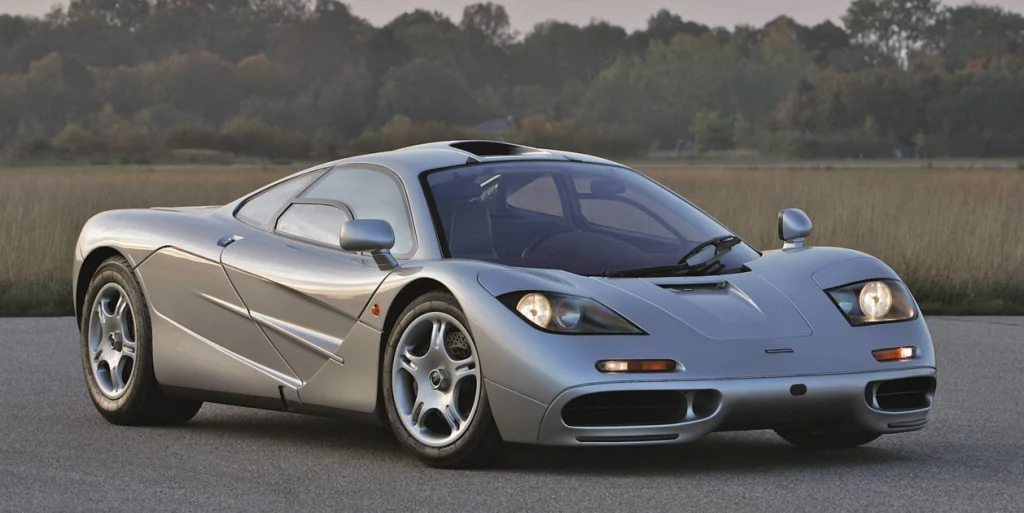McLaren’s team of engineers were determined to craft an uncompromising road car when designing the F1. Any compromise would diminish driver pleasure – and ultimately betray the purpose of this endeavor.
Murray’s principles included ground-effect aerodynamics, cab forward driving positions, spinal air intakes and large, linear power delivery from naturally aspirated engines – creating machines capable of breaking speed records and winning championships.
POWER
Due to a lack of modern traction control, ABS, or power steering technologies, driving the McLaren F1 requires an experienced driver who can navigate its immense acceleration. While its brake pedal feels heavy at first glance, its accuracy and responsiveness to input make this car an unparalleled driving experience.
Murray insisted that the F1 would be designed with pure racing in mind, which meant anything that diminished driving pleasure was off limits. Small, low-drag packaging and an optimal cab-forward driving position were essential features to maximize speed.
McLaren F1s unwavering commitment to performance has resulted in cars that remain fast and enjoyable to drive even today, even without advanced features such as launch control or dual clutch transmission. They still far outshone contemporary competitors.
HANDLING
McLaren’s F1 car demands a driver of exceptional skill. To maximize its full potential, steering and throttle need to work in harmony for maximum results. Although initially intimidating, once you learn its unruly characteristics you’ll leave any other supercar in its wake.
The steering is swift and responsive. The lack of kickback proves how effective electronic stability control is without compromising driving feel; something no other car has done successfully.
The engine in this car is state of the art, featuring infinitely variable cam phasing and 11.0:1 compression ratio. Specifically designed and constructed for this vehicle with its own carbon-fiber monocoque, each part being engineered down to every detail.
PERFORMANCE
McLaren has long been revered as one of the premier manufacturers in automotive performance. After an otherwise difficult 2020 campaign that saw Fernando Alonso suffer rib fractures and lung collapse from an accident at the Australian Grand Prix, McLaren is back on track with its production line this year.
The F1’s design was guided by two key issues common among supercars: offset pedals and poor visibility. Engineers designed an extremely light car so as to meet Murray’s goal of saving 50 percent weight from previous versions of component products.
McLaren cars still carry signature features of the F1, such as its carbon tub, dihedral doors, and flat underbody design. Its computer-controlled braking system ensures an even distribution of load under intense g-forces and keeps it standing still under high speeds.
COMFORT
McLaren’s dedicated small team reimagined every element of sports car design using their Formula 1 expertise and uncompromising philosophy to reduce weight, drag, and increase downforce.
The result was a car that epitomized moon-shot fun and creative freedom; even now it remains difficult to beat.
On a glorious autumn day at Navarra Circuit in northern Spain, we gave the F1 its inaugural test drive. It proved to be a perfect track for it with fast bends and plenty of space to provide confident driving – as well as two long straights where speeds that would normally require lengthy jail terms could be reached safely.
COMMUNICATION
Team success relies heavily on its ability to read and interpret data effectively, so the McLaren F1 features many sensors which produce massive amounts of performance-boosting information with every race week.
Peter Stevens (known for designing the Jaguar XJR-15 and Lotus Elan M100 among many other iconic automobiles) designed the McLaren F1 as a Group C endurance sports car that was transformed into a compact road legal supercar with plenty of flair. Even today, its stunning aesthetic still draws gazes and brings envy from passersby.
McLaren F1 remains a force within Formula 1. Lando Norris and Oscar Piastri continue to demonstrate their racing prowess on track and appear poised to bring championship glory back to McLaren by 2024.
VALUE
McLaren has gained an edge by being able to quickly make strategic decisions during races based on data analysis and advanced simulations. These decisions often have immediate effects.
Formula One champions for the first time. However, one year later they struggled.
As opposed to today’s hypercars, the McLaren F1 did not rely on massive wings or spoilers for downforce; its sleek wingless design provided a minimalist appearance while still taking full advantage of modern groundforce effects.
Purity of purpose extends to the driving experience as well. The McLaren F1 grips the road securely, necessitating courage from drivers in order to unlock its full potential.
About Author
You may also like
-
Adapting Cars for Extreme Weather Climate Changes: A Driver’s New Reality
-
Minimalist Car Ownership: Smart Downsizing Strategies for Less Stress and More Freedom
-
Car-Sharing in the Countryside: A New Road to Rural Freedom
-
Your Car, Your Schedule: The Unstoppable Rise of Mobile Detailing and On-Demand Car Care
-
Revving Up: The Latest Trends in Car Modifications for 2025
 Restoration Techniques for Vintage Car Electrical Components: A Hands-On Guide
Restoration Techniques for Vintage Car Electrical Components: A Hands-On Guide 

